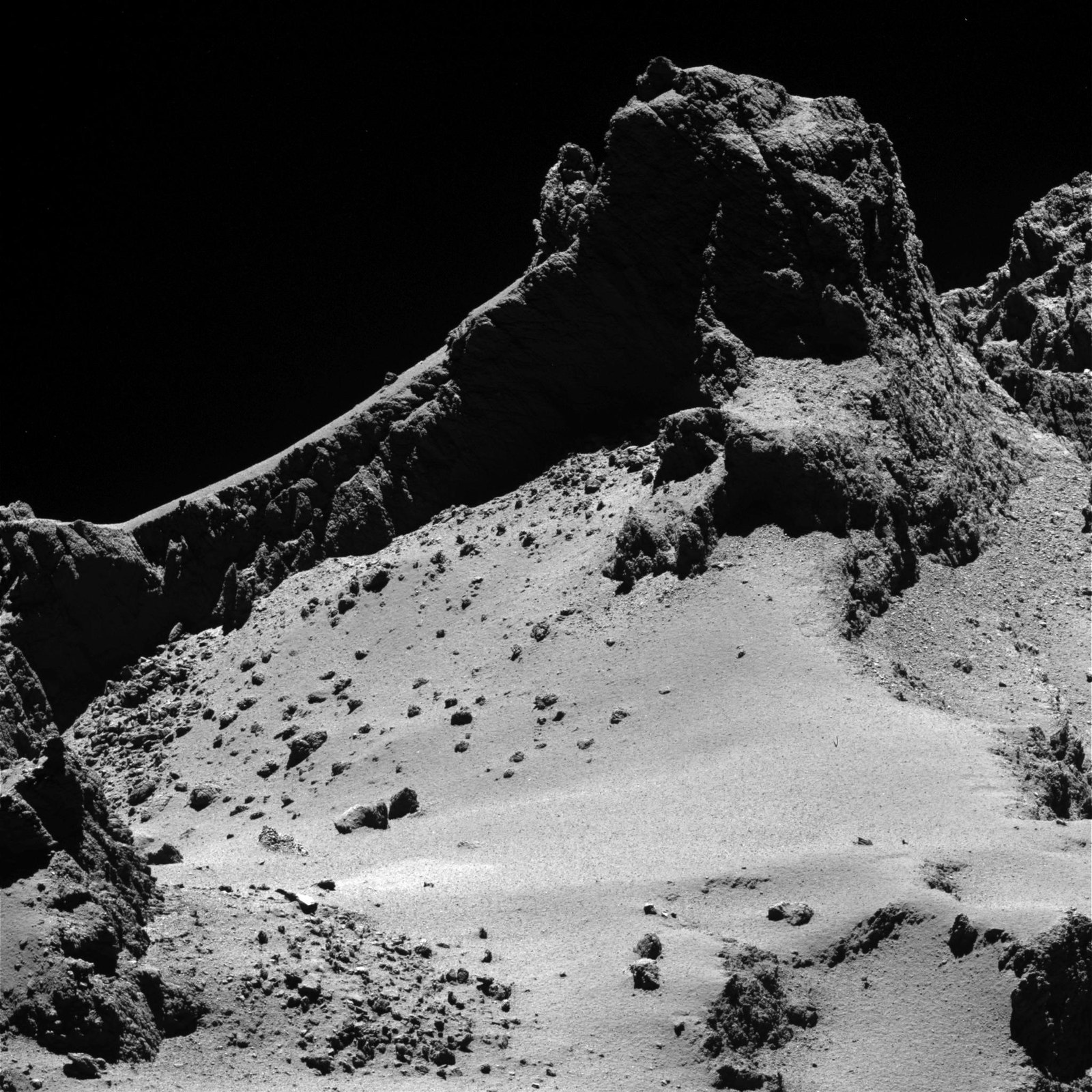Comet Churyumov-Gerasimenko – pitch black and full of contrasts

ESA/Rosetta/MPS for OSIRIS Team MPS/UPD/LAM/IAA/SSO/INTA/UPM/DASP/IDA.

ESA/Rosetta/MPS for OSIRIS Team MPS/UPD/LAM/IAA/SSO/INTA/UPM/DASP/IDA.

It is still early days for the scientists involved in evaluating data that the 21 instruments on board the Rosetta spacecraft and its Philae lander have transmitted back to Earth. But preliminary results from seven of the 11 instruments on the Rosetta orbiter have been published in a special edition of the journal Science. Here, the extremely dark-coloured comet 67P/Churyumov-Gerasimenko is contemplated as a remarkably heterogeneous body with a varied surface enveloped in a changing coma and exhibiting structures similar to 'goose bumps', which the researchers have yet to explain. "At the moment, we are analysing and discussing the next batch of data," says DLR comet researcher Ekkehard Kührt, responsible for DLR's scientific contribution to the Rosetta mission. "There is still plenty about Churyumov-Gerasimenko that we need to decipher."
Comet 67P/Churyumov-Gerasimenko is among the darkest objects in the Solar System – the Visible, Infrared and Thermal Imaging Spectrometer (VIRTIS) has revealed that its surface reflects a mere six percent of the incident solar radiation. A reason for this may be the dark materials such as iron sulphides, dark-coloured silicates and carbon-rich compounds deposited across the comet's surface. "It is very likely that there is little or no frozen water directly on the surface of the comet's nucleus," says Gabriele Arnold, a DLR scientist on the VIRTIS team. "But there is, undoubtedly, frozen water inside the comet." The process of sublimation that has occurred during the comet's journey through the Solar System has most likely stripped 67P/Churyumov-Gerasimenko of the bulk of frozen water once found in its outermost layers.
Detection of organic compounds
"The identification of long chain hydrocarbons is among the most interesting discoveries," says the planetary scientist. Confirmation of the existence of these organic compounds – precursors to amino acids – on a comet's surface would not have been possible via ground-based observations. "These compounds can only form through complex reactions at low temperatures under exposure to ultraviolet or cosmic radiation. The conditions for this are only found in the outer reaches of the Solar System, beyond the orbit of Neptune.” So Churyumov-Gerasimenko may allow the planetary researchers to look back into the early life of the Solar System.
Coma changes as the comet 'day' progresses
Measurements conducted using the Rosetta Orbiter Spectrometer for Ion and Neutral Analysis (ROSINA), a highly sensitive mass spectrometer able to confirm the presence of molecules and ions even in the extreme vacuum of the comet’s coma, have indicated that the comet's nebulous envelope consists mainly of water, carbon dioxide and carbon monoxide. "It is interesting to note that the mass ratio between these three constituents varies significantly over the course of one comet day," explains Kührt, a member of the ROSINA science team. At times, the mass spectrometer has recorded a substantially higher proportion of water molecules, and then a sharp increase in carbon dioxide molecules, as the comet rotates. “This indicates that the frozen materials that release the gaseous molecules are unevenly distributed across the nucleus." During the course of the mission, the scientists hope to identify whether the comet's formation many billions of years ago produced this heterogeneity, or if it is the result of differentiation processes later on.
Dunes and 'goose bump' protuberances
Evaluation of data from the Optical, Spectroscopic, and Infrared Remote Imaging System (OSIRIS ) has shown extremely varied structures spread across the comet's various regions. Roughly 70 percent of the comet’s surface has been mapped – although the southern hemisphere, uncharted to date, requires further examination. The scientists have identified 19 different regions, giving them the names of Egyptian gods. A rough categorisation acquired through analysis of the camera's images revealed five distinctive types that predominate on the surface: dust-shrouded areas, brittle material, large-scale depressions, smooth terrains and exposed, consolidated structures. "The comet possesses an extremely heterogeneous surface that is anything but uniform," says Kührt. The OSIRIS images also show dune-like patterns, alongside elevations with a diameter of around three metres, not dissimilar to 'goose bumps', whose creation process requires further analysis and clarification.
Mysterious makeup
The exact cause of the comet's unusually formed nucleus is another mystery. Resembling a rubber duck, a slender neck connects the head and larger body of 67P/Churyumov-Gerasimenko. It is conceivable that the path of two individual comets intersected and they formed one unified body. It is also possible that erosion produced the slender neck, forming two 'body parts' in one comet. What the OSIRIS images have shown quite clearly thus far is that the narrow area connecting the two sections of the comet is the most active zone, emitting gas and blasting dust particles out into space.
Ekkehard Kührt, a scientist at the DLR Institute of Planetary Research, is sure: "We will continue to analyse the data we have acquired from the approach, the orbit and the landing. There is no doubt that we will discover a great deal more about 67P/Churyumov-Gerasimenko, and that this will help us learn more about the formation of the Solar System."
